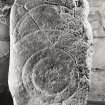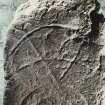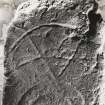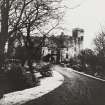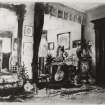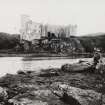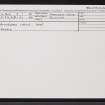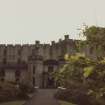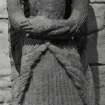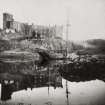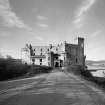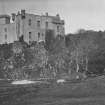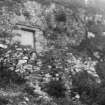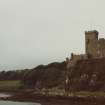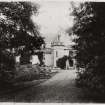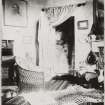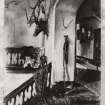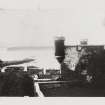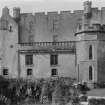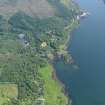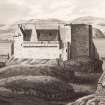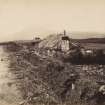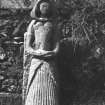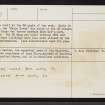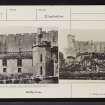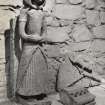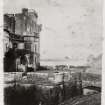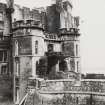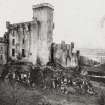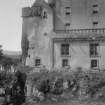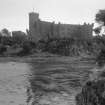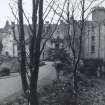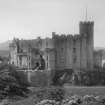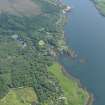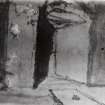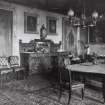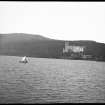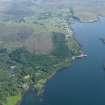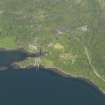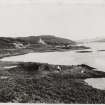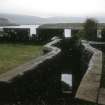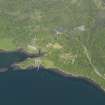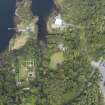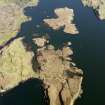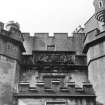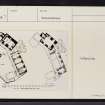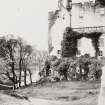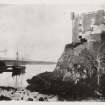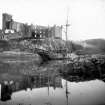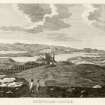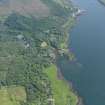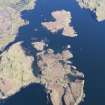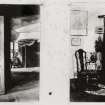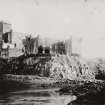Skye, Dunvegan Castle
Bridge (Period Unassigned), Castle (Medieval), Causeway (Period Unassigned)
Site Name Skye, Dunvegan Castle
Classification Bridge (Period Unassigned), Castle (Medieval), Causeway (Period Unassigned)
Alternative Name(s) Began's Dun; Gatepiers; Causeway; Bridge; Dunvegan Castle Policies; Dun Bheagan
Canmore ID 10835
Site Number NG24NW 7
NGR NG 24740 49106
Datum OSGB36 - NGR
Permalink http://canmore.org.uk/site/10835
- Council Highland
- Parish Duirinish
- Former Region Highland
- Former District Skye And Lochalsh
- Former County Inverness-shire
Dunvegan Castle, 13 th century and later, occupying an earlier Norse site The seat of the Macleod chiefs (see P.257) belongs to a large group of Gàidhealtachd strongholds (for example, Tioram, Dunollie and Dunstaffnage), the key elements of which still survive beneath the castle's largely 19th century appearance. Situated high on a sea-girt plug of basalt overlooking Loch Dunvegan, the present structure was begun, probably in the 13 th century, with a curtain wall that completely enclosed the promontory; fragments of this can still be seen. It was accessed through the sea gate, the only entrance until 1748, which survives still. At the back of the enclosure would have been the main building, or feasting hall, with associated buildings. In the late 14 th/early 15th century a large tower house was added to the north - a four-storey structure with defensive features, built to provide fashionable family accommodation. In about 1500, the Fairy Tower, a smaller, independent tower house probably intended for guests, was added by Alasdair Crotach, the 8th chief, on the south-east corner of the enclosure. During the Renaissance, the feasting hall was replaced by a fairly typical 'main house' of state apartment above cellars with accommodation above, built by Ruairidh Mor, 15th Chief, in 1623 . His grandson, Iain Breac, added the splendid landward-facing Pipers' Gallery in 1664, the detail of its balustrading very reminiscent of Craigievar's belvederes; in 1684-90 he added the south wing. As was customary at this period, the old tower was abandoned for the more comfortable living quarters. It remained roofless until 1790-1, when the architect/mason Walter Boak began the Georgianisation of the castle for Gen. Norman, the 23 rd chief. The hall of the re-roofed tower became the present drawing room - incongruously, just feet from the pit dungeon below - and among other additions was a barrack block on the north-west corner of the complex. In line with fashion and the fortunes of the Macleods, Dunvegan became increasingly modernised and homogenised, with spurious battlements concealing genuine antiquity. Sir Walter Scott, visiting in 1814 , noted approvingly the efforts of John Norman, 24 th Chief, to 'medievalise' the castle 'by making a portal between two advanced towers and an outer court, from which he proposes to throw a drawbridge over to the high rock in front'. (John Norman also continued the planting begun by his father and built the walled garden and other ancillary buildings). Further mock battlements and other alterations, including the eastern approach bridge, new porch and thinly Jacobean-style internal remodelling, were made by Robert Brown Jnr in the 1840s for Norman, the 25th chief. The west-facing dining room and library, arranged as a suite with interconnecting Georgian-style doorcases, are of this period, as is the billiard room (now the North Room) in the former barrack block. Among the prize trophies preserved inside the castle are the famous Fairy Flag, the Dunvegan Cup, and Ruairidh Mor's Drinking Horn. Ancillary buildings include: Laundry Cottage, dated 1734 , long and low with moulded architraves and crowstepped gables, formerly the estate office/factor's house, later the laundry. Stables/coachhouses/steadings, 1811 , a roofless U-plan court in handsome classical style, with pavilioned corners and ends emphasised by great, round-arched recesses, and smart dressings of pale ashlar. The adjacent sawmill retains its old machinery. The Cottage, 19th century addition to earlier core - one time dower house, pretty with latticed mullions, an older, thick-walled dwelling still evident behind its cottagey Tudor front.
Taken from "Western Seaboard: An Illustrated Architectural Guide", by Mary Miers, 2008. Published by the Rutland Press http://www.rias.org.uk
NG24NW 7.00 24740 49106
NG24NW 7.01 NG 24629 49540 Stables; Saw Mill
NG24NW 7.02 NG 24669 49025 Laundry
NG24NW 7.03 NG 2482 4897 Gardens
NG24NW 7.04 NG 24756 48891 Walled garden and sundial
NG24NW 7.05 NG 24768 49071 Bridge
See also:
NG24NW 13 NG 24700 49616 Dunvegan Estate, The Cottage
NG24NW 42 NG c. 248 490 Dunvegan Estate, Gardener's Cottage
NG24NW 43.00 NG 248 490 Dunvegan Estate, General
NG24NW 43.01 NG 248 496 Dunvegan Estate, Manager's House
Dunvegan Castle occupies the summit of a rock which projects on to the eastern shore of an inlet. On the landward side it is isolated by a ditch, partly natural and partly artifical, about 60ft in width and 18ft in present depth. There seems little doubt that the rock was the site of a dun of some island chief at an early date. The name is said to mean 'Began's Dun'. All traces of any prehistoric structure seems to have been swept away for the medieval works.
In the 13th century, after the annexation of the Western Isles by Alexander III in 1266, the summit of the rock was enclosed with a certain wall with arched entrance, the sea gate, from which steps led up to yhe platform area, the only entrance to the castle till 1748. In the second half of the 14th century, a keep, 48ft by 35ft, was built at the NE angle of the rock. Early in the 16th century, the 'Fairy Tower' was added at the SE corner, and between these two towers extends Roy Mor's work, erected 1623. The SW wing was built between 1684 and 1690. All these buildings have been much altered by the 19th century transformation.
RCAHMS 1928; W D Simpson 1963.
Dunvegan Castle, the ancestral home of the Macleods, is the private residence of Dame Flora Macleod of Macleod. It is described above, and is in excellent condition.
Visited by OS (A S P) 17 May 1961.
OWNER: Dame Flora MacLeod of MacLeod
ARCHITECT: William Burn (?)
Robert Brown - remodelling work 1840 - 50
Colin Sinclair - repairs after fire 1938 - 40
NMRS LIBRARY
'Scottish Country Life' May 1930, page 140 - photograph.
NMRS REFERENCE:
Dunvegan Castle, The Danish Tower.
Also referred to as the Danish fort.
DUNVEGAN CASTLE DRAWINGS
NMRS Photographic survey of drawings at Dunvegan Castle including; designs for additions to Dunvegan Castle by Robert Brown 1840 etc.
Copied 1982 Inventory 107
DUNVEGAN ESTATE OFFICE DRAWINGS
Nmrs Photographic curvey of Dunvegan Estate Office drawings copied per SRO including: survey plans of Dunvegan Castle by K and E MacKenzie 1920; design for improvement to Castle kitchens 1939; designs for restoration after fire of 24th November 1938 by Colin Simpson 1939; contract drawings for Dunvegan Hotel by Alexander Ross 1868; designs for Dunvegan Village Hall 1894; designs for estate buildings and a survey of St Kilda by John Mathieson.
Copied 1979 Inventory 107
EXTERNAL REFERENCE:
SCOTTISH RECORD OFFICE
1. Plan of part of castle showing proposed alterations
2. West elevation.
[1840]
Billiard room on level with present drawing room. MacLeod Private Collection
Plans of 2nd and 3rd storey of North wing. Give dimensions in great detail. c.1812
Field Visit (8 September 1922)
Dunvegan Castle.
Dunvegan Castle, the seat of McLeod of Dunvegan, is the most considerable of the historic structures in Skye, and is singular in possessing details of architectural merit. It occupies the summit of a rock in a sheltered and almost landlocked bay on the eastern shore of Loch Dunvegan, that rises to a height of from 20 to 25 feet, is enclosed by sea on three sides, and is separated from high ground on the east or landward side by a gully 16 yards wide and 15 feet deep in places, which is mainly natural. As the rock can be scaled at several points, the terre plein is defended by a wall returning round the perimeter, which in time has come to be incorporated in buildings to north, south and east. From Grose's view of the castle, published in 1790, before the modern alterations and additions were made, it is apparent that the nucleus of the whole is the large tower at the north-east angle which dates in or about the 15th century and formed a dwelling complete in itself. This was slightly altered in the 16th century, and in the same century increased accommodation was provided by building the new house with the "Fairy Tower" between the southern angle and the 15th-century tower; some part of this addition was renewed and embellished in 1686. In or towards the 18th century the old tower was ruinous and disused, and was replaced by a wing on the west of the 16th century house. Within relatively modern times the old tower was restored and modernised, and was linked up to the 16th-century house by an addition containing a vestibule and porch ; the 16th-century house was widened and heightened, and the castle as a whole was finished in the then fashionable battlemented "baronial" style. The access was originally only from the west, but this was subsequently supplemented by a side gate on the east, reached from the bed of the gully by a flight steps; when the porch and vestibule were added the gully was bridged and the west entrance went out of use.
In the 15th century the castle comprised a barmkin about a quarter of an acre in extent, irregularly shaped, with the house tucked away in the north-east angle. The barmkin wall probably was surmounted by a roundway, for there are corbels on the south-east angle of the "Fairy Tower," which cannot be explained if they were not for the purpose of supporting a parapet. The barmkin entrance, set on the western side, was fairly wide, and had an arched head, but in the 16th century it was constricted by inserting moulded jambs and lintel, the latter enriched with a ribbon and baton moulding. The entrance was defended by two swinging gates with an intermediate rising gate, which can hardly be dignified as a portcullis. Past the gates the access leads straight up to the barmkin level and passes on the south the draw well, but just within the innermost gate a narrow branch led up to the tower entrance. (Fig. 217.[SC 1104768])
The tower on plan comprises an oblong main block 48 ¼ by 35 feet, with a jamb or wing 11 by 14 ¾ feet unusually placed, for it projects from a gable. The entrance seems to have been at first floor level in the north-west, re-entering angle on the site of the door now opening between the drawing room and billiard room; some distance above this is a machicolation. Main block and wing were both four storeys in height, but the wing has been heightened in the last alterations. The masonry is rubble harled built of stone excavated on or near the site, but the dressings are of imported freestone. Those inserted in the 16th century are distinguished by being delicately moulded. The basement floor is vaulted with a barrel vault and comprises a cellarage, which became the kitchen in the 16th century. At the eastern end a mural staircase descends and gives access from the Hall, which occupied the first floor. The lower storey of the wing is a pit or prison originally reached from a hatch in its vault, but subsequently entered from a small 16th-century door in the east wall. The pit ventilated into the mural staircase. The Hall, which has been modernised as the drawing room, measures 30 ¾ by 20 ¾ feet. The windows in the lateral walls are modern. The only original feature is a small mural chamber at the southern angle. The staircase, which must have risen from this floor to the roof, is not apparent, but it is conjectured that it lay in the west wall, for in that wall externally is seen a small window which cannot otherwise be accounted for. Within the wing at the level of the Hall is a small chamber with a vaulted roof, lit from north and east by narrow slits ;above this is a second chamber with a garderobe in the gable and narrow slits in the lateral walls. The two floors in the main block above the Hall are quite modernised.
The 16th-century house comprises the graceful little "Fairy Tower," a four-storey structure at the south-east angle, and the four-storeyed wing extending northwards from that tower (Fig. 218 [SC 1104769]). Both these portions are modernised internally, but the tower still retains its crenellated parapet and walk, while the wing has a good Renaissance balustrade, added in 1664. Preserved in the wine cellar are some details removed from the wing during the latest alterations: (a) is a panel with a lengthy inscription in Latin, now very weatherworn and almost illegible, but apparently to the effect that John McLeod (Iain Breac) and Flora McDonald, his wife, restored the wing in 1686 ; (b) a dormer pediment inscribed F MD beneath a thistle slip; (c) a second pediment bearing a lion rampant. On the upper part of the modern porch is a long armorial panel c. 17th century, stated to have been removed from another building. The central shield, supported by lions, griffins rampant regardant, holding swords and surmounted by a crown and label, is parted per pale and charged dexter a castle at fess between the three legs of Man in chief and a bull's head cabossed at base, and sinister a galley beneath a lion rampant and a right hand grasping a cross crosslet. The label is upheld by angels. The panel is otherwise filled with such decorative motifs as foliage, two banners opposed, animals lying and standing, and an object resembling a female figure on a helm. The impaled arms are those of Iain Breac, chief from 1664 to 1693, and his wife, Flora Macdonald of Sleat. (Fig. 220.)
In the courtyard are the symbol stone described in Article No. 528 and a very interesting female figure in 17th-century costume which apparently bore a sundial (Fig. 219). A very similar figure, which came from North Barr, Ayrshire, is now at Lennoxlove, East Lothian [NT57SW 29].
RCAHMS 1928, visited 8 September 1922.
OS map: Skye xxi.
Photographic Survey (September 1964)
Photographic survey of Dunvegan Castle, Inverness-shire, by the Scottish National Buildings Record/Ministry of Works in FSeptember 1964.
Photographic Survey (February 1965)
Photographic survey of Dunvegan Castle, Inverness-shire, by the Scottish National Buildings Record/Ministry of Works in February 1965.
Publication Account (1985)
Dunvegan Castle, the ancient seat of the MacLeods of Dunvegan and Harris, stands on a rock on the east shore of Loch Dunvegan, protected from the landward side by a deep gully. The oldest part is the keep, dating probably to the 14th century, a four-storey tower similar to those at Kisimul (no. 29), Caisteal Uisdein and Castle MaoL and was used as a dwelling as well as a defensive structure. As at Kisimul the original plan included a wall enclosing a courtyard, with the only entrance through the sea-gate. There is a well in the courtyard which belongs to this period. The tower has a small wing on the north-west gable. The barrelvaulted room at the base of the tower was originally a cellar, but later became the kitchen. At the same level in the wing is the dungeon, entered from the floor above by a trap door. The hall occupies the first floor of the tower.
In the 16th century Alasdair Crotach, whose elaborate tomb is in the church at Rodel (no. 49), built the 'Fairy Tower' within the south-east angle of the wall, providing further accommodation. In the 17th century the space between the two towers was built over by Rory Mori this house included a spacious dining-room and a library. By the late 17th century, the tower had fallen into disuse, and a wing was built onto the Fairy Tower.
Late in the 18th century, a further building was added, to the north-west of the tower, a barracks to hold men of the 2nd Battalion Black Watch which the General the 23rd Chief of the Clan MacLeod, was raising locally. Part of this now houses an exhibition including material about Clan MacLeod, local history, and St Kilda, which belonged to the family for several centuries. Amongst the items on view are the famous 'Fairy Flag', a silken banner of Eastern origin, said to have been given to one of the chiefs by a fairy and to provide magical protection for the clan when waved; and the Dunvegan Cup, a beaker of bog oak with mountings of silver and precious stones, and an inscription which dates from the later 15th century. The imposing front entrance was built early in the 19th century, and access was then possible from the landward side across a bridge. An old armorial panel was built into the porch. The tower was restored and modernised in the mid 19th century, when other alterations were made and the whole castle finished in the 'Baronial' style.
Information from ‘Exploring Scotland’s Heritage: Argyll and the Western Isles’, (1985).


















































































